Christine Valters Paintner's Blog, page 102
June 13, 2017
Monk in the World Guest Post: Anne Buck
I am delighted to share another beautiful submission for the Monk in the World guest post series from the community. Read on for Anne Buck's reflection on "In Between Light and Dark."
It was the middle of the night and I was asleep. But maybe, just possibly I was awake. Maybe it was the pain medication or the muscle relaxant. It could have been exhaustion or chemotherapy or my imagination. In the fuzzy dark, I heard a trapped and caught animal, screeching for life and I could not open my eyes, I couldn't move, even though I felt the life draining out of my bones with every scream.
I have been diagnosed with non-Hodgkin's lymphoma. One day I was fine, the next day I was planning my funeral. As the New Year began, my doctor checked out an ongoing ache in my back. Following a Sunday afternoon MRI, back surgery was scheduled for early March followed by rounds of chemotherapy. A mass was found in my spine on my low back and the medical team was hopeful that chemotherapy and radiation would address it. Surgery, placement of a port, PET scans, MRIs, days of chemotherapy, nights buried under covers, and no one ever used the word cancer. Only my own mind reeled with the possibility.
Lent was unsettling and intense as I considered death and loss in a new way. Darkness has been a constant container. Fistfulls of hair began to fall out and I lost it all on Easter Sunday. This season has been a deeply solitary time. I haven't wanted to interact much. I'm tired of telling people I'm tired and something is wonky with my brain and I know it just isn't easy for others to sit with a sick person. I am not used to being "weak" and/or unable to function.
This is not something I ever imagined going through and sometimes struggle with feeling hopeless.
So, in the hopelessness and darkness, in the moments of sickness and aching, I have to ask myself the questions that bring meaning. “What is it like to be in the dark?” “Can hopelessness be part of the journey?” “Is it possible to rest without struggle in the darkness, trusting that all will be well?”
Over the last months I am learning to welcome the hopelessness and darkness. I welcome myself. I am leaning to offer myself gentleness in a new way. It is in this place that I am beginning to understand what healing means. My story is in the now. Not how I was before my illness and not looking forward to a year from now when this is over. Now is the time to be present. Now is the struggle. And yet, now is the time to rest. The time to be still and breathe, the time to allow my body to follow what is next.
I am not sad or depressed yet there are times I cry without ceasing. In the midst, I take comfort from so many around me that write and pray and connect. A friend made a meal train for us – I couldn't imagine anyone would sign up. Yet, this is how people show their care. Friends from high school, from work, from The Dougy Center, from a previous church, from people I don't know, from the Abbey of the Arts though a woman I connected with in one of the very first online classes, Monk in the World, Melinda, who lives in England and has a friend in Portland. She signed up for a meal and cared for me. How wide the net of love and care spreads!
I am releasing and carrying.
Healing and dying.
Awake and asleep.
Settled and anxious.
Surrounded and isolated.
Resting and waiting.
Light and Dark.
Winter. Summer.
And in the midst, all is well.
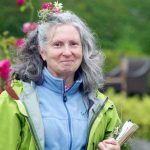 Anne intuitively uses her compassion and creativity to midwife people through life experiences and transitions. As a chaplain, a massage therapist, a certified labyrinth facilitator and a spiritual director, she is able to be with others as they deal with end of life decisions, relationships and the meaning of faith through body awareness, walking journeys and creative expression.
Anne intuitively uses her compassion and creativity to midwife people through life experiences and transitions. As a chaplain, a massage therapist, a certified labyrinth facilitator and a spiritual director, she is able to be with others as they deal with end of life decisions, relationships and the meaning of faith through body awareness, walking journeys and creative expression.
June 12, 2017
Writing on the Wild Edges – Participant Poems (Christine Davis)
This past April we led one of our Writing on the Wild Edges retreats on the beautiful island of Inismor off the coast of Galway. We will be sharing some of the writing which participants gave us permission to share here in the next few weeks. Up next are poems by Christine Davis.
(If you'd like to join us, we have our dates open for 2018 – August 26-September 1)
Focail do a Chara (Words for a Friend)
Liturgy of Stillness and Rock
Liturgy of stillness and rock,
Tell me your stories.
I am from a people who dream dreams of places they have never been;
open the gates of my soul and let it run!
Tell me your stories.
I am but a whisper in the passage of time.
Open the gates of my soul and let it run.
Space and time cannot be separated.
I am but a whisper in the passage of time.
I am from a people who dream dreams of places they have never been.
Space and time cannot be separated.
Liturgy of stillness and rock.
Upon Returning Home
I sit surrounded by the remnants of my half-unpacked suitcase,
sending gratitude as I load the wash.
I savor each memory:
the clothes that covered my vulnerability:
the ones that kept me warm in fierce winds,
and kept me dry in hail and storm;
this one gave me comfort to sit and write;
this other eased my walk in contemplation and stillness;
this sweater, lovingly knitted by hands that never knew me,
brought me home to my body day after day;
my favorite shirt lulled me to sleep;
and my new knit slippers padded the way to coffee and companionship.
My gloves, my hat, my hiking shoes, went with me in silence to monastic ruins and holy places;
and my yoga pants danced with me in embodied prayers.
These clothes hold secret longings and discoveries,
poems written and yet to write.
They hold the love felt deep within my body.
They hold the sky, the sea, the wind, and the earth.
I wash them clean but hold on to the holy memories.
My Holy Place
I found where sea, sky, and earth meet,
a holy place.
I found where saints and sinners come together,
a holy place.
I discovered a world of long forgotten dreams and
new hopes and death stones so old they are worn new.
I discovered the new emerging from the ancient.
I discovered my joy.
Haiku
Tiny buttercup,
hiding at the foot of stalks.
Accepts where it is.
In ancient lands still
alive, ruins and homes are
one and the same thing.
Long layers of soil,
homes with thatched roofs dot the earth,
clouds bridge to the sky.
I wonder if my
ancestors walked here; it feels
much like home to me.
—All photos and poems © Christine Salkin Davis, 2017 (click here to visit her website)
June 11, 2017
Call for Submissions: Monk in the World Guest Post
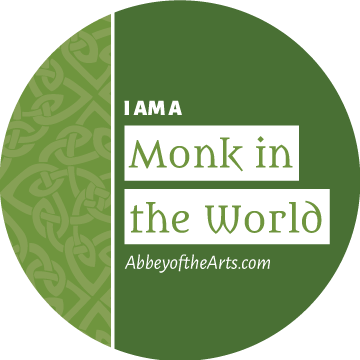 We welcome you to submit your reflection for possible publication in our Monk in the World guest post series. It is a gift to read how ordinary people are living lives of depth and meaning in the midst of the challenges of real life.
We welcome you to submit your reflection for possible publication in our Monk in the World guest post series. It is a gift to read how ordinary people are living lives of depth and meaning in the midst of the challenges of real life.
There are so many talented writers and artists in this Abbey community, so this is a chance to share your perspective. The link to the reflection will be included in our weekly newsletter which goes out to more than 11,000 subscribers.
Please follow these instructions carefully:
Please click this link to read a selection of the posts and get a feel for the tone and quality.
Submit your own post of 700-900 words on the general theme of "How do I live as a monk in the world? How do I bring contemplative presence to my work and/or family?" It works best if you focus your reflection on one aspect of your life or a practice you have, or you might reflect on how someone from the monastic tradition has inspired you. We invite reflections on the practice of living contemplatively.
Please include a head shot and brief bio written in the third person (50 words max). You are welcome to include 1-2 additional images if they help to illustrate your reflection in meaningful ways. All images should be your own. Please make sure the file size of each the images is smaller than 1MB. You can resize your image for free here.
We will be accepting submissions between now and August 31st for publication sometime in the late summer/fall 2017. We reserve the right to make edits to the content as needed (or to request you to make edits) and submitting your reflection does not guarantee publication on the Abbey blog, but we will do our best to include as many of you as possible.
Email your submission by August 31st and include the reflection pasted into the body of your email and attach your photo(s).
We will be back in touch with you at the latest by the beginning of September to let you know if your post is accepted, if edits are needed, and/or when we have scheduled your post to appear.
June 10, 2017
Feast of St. Columcille + Self-Study Sale ~ A love note from your online abbess
 Delightful to me to be on an island hill,
Delightful to me to be on an island hill,
on the crest of a rock,
that I might often watch the quiet sea.
That I might watch the heavy waves
above the bright water, as they chant
music to their Father everlastingly.
That I might watch it's smooth, bright-bordered shore,
no gloomy pastime, that I might hear the cry
of the strange birds, a pleasing sound.
That I might hear the murmur of the long waves
against the rocks, that I might hear
the sound of the sea, like mourning beside a grave.
That I might watch the splendid flocks of birds
over the well-watered sea, that I might see
its mighty whales, the greatest wonder.
That I might watch its ebb and flood in their course,
that my name should be–it is a secret that I tell–
"he who turned his back upon Ireland."
—Poem attributed to St. Columcille
Dearest monks and artists,
The feast of St. Columcille was two days ago on June 9th. He is also known as Columba (which means “dove” in Latin), and is one of the three patron saints of Ireland (in addition to St Patrick and St Brigid) and was born in Co Donegal. His birth was foretold in his mother’s dream of a youth receiving a radiant cloak which spread over Ireland and Scotland.
He came from a family of Kings, but at an early age was given over to a monastery where he surrendered any royal claims he might have had, and founded many monasteries across Ireland, including Derry, Durrow, and likely Kells, and as far west as the Burren in Co Clare where there is still a holy well dedicated to him. He was also a poet and loved manuscripts.
Columcille experienced a call to leave Ireland and become an exile. He found it very painful and spent the night before his departure on what is now known as the “flagstone of loneliness.” For many of the Irish monks, this call to exile was an integral part of the peregrinatio journey, to release all that is familiar and make oneself reliant on the hospitality of strangers, to feel your radical dependency on God.
In the year 563, he travels with twelve other monks to cross the sea in a coracle and landed on a small island off the coast of Scotland, now known as Iona. It was here that he began his new work and Iona became a heart center for Celtic Christianity.
From Iona, many other monastic settlements were founded across Scotland, out to the Hebrides, while also maintaining his influence on his monasteries back home in Ireland. He was a poet and an artist who did illumination, including perhaps even some of those in the Book of Kells itself.
There is a beautiful story about his encounter with a crane. Birds were considered to be divine messengers in the Celtic world. The crane was said to be one of the first birds to greet the sunrise, the threshold time, connecting it with the direction of the east, and is associated with knowledge and wisdom. As the Druidic tradition gave way to Christianity, sometimes the term “Crane Cleric” was used to indicate great wisdom in certain priests, such as St. Columcille.
One day a crane arrived to Iona after much travel and exhaustion. It landed on the shore quite exhausted and hungry. Columcille told one of his monks that the crane had come from Ireland and to nurse it back to strength and health for three days until it was well enough to return on its own again. The bird was lovingly tended as an honored guest in the great tradition of monastic hospitality.
I love this story for its many layers. The bird is a stranger seeking refuge and hospitality, given to it freely by the monks. The crane is a symbol of thresholds and wisdom, as it lives in the border spaces between land and sea. Three days it took to be restored links it to Christ and to the sacred number of three held dear by the Celtic imagination.
Sometimes in our own journeys, we need to recognize when we are called to land for a while and seek solace and nourishment in a strange place.
With great and growing love,
Christine
Christine Valters Paintner, PhD, REACE
Dancing monk icon © Marcy Hall (prints available in her Etsy shop)
June 6, 2017
Monk in the World Guest Post: Jane Tomaine
I am delighted to share another beautiful submission for the Monk in the World guest post series from the community. Read on for Jane Tomaine's reflection on Little Dresses for Africa.
Sometimes it is just hard for me to get going. Tasks mill around my head like my cats before meal times, walking between my legs, mewing impatiently, rubbing on my ankles to make sure that I don’t forget them. But unlike the cats, there are tasks that I just can’t seem to get to. Have you experienced this dilemma? What is it that we cannot seem to begin? Is it a phone call that promises to be difficult or a long, needed repair or task at home that we dread tackling; is it a project we really want to do, but that’s languishing on the back burner because we aren’t sure how it will fit into an already stuffed day?
In the monastery the bell calls the monastics to prayer. Is it possible that our neglected and avoided tasks are really bells that ring of opportunities to connect us more deeply with God and others? Do these tasks mew like Charlotte, Ricky, Espy and Nikki (my cats) until we take them up and find in them the prayer of our heart?
Until the early 1990’s I was an avid seamstress, sewing nearly everything that I wore. Seminary and then fulltime parish ministry left no time for this once delightful and productive creative work. For years the cabinet that housed my sewing machine was never opened, becoming instead another flat receptacle for books, papers, and a variety of sundry items. A couple years ago I decided to give away both machine and cabinet. Wanting to make sure all was in good shape, I gave both a good dusting, applied oil, and ran a scrap of fabric through to make sure that machine worked. That was the surprise! It was like putting on an old shoe – I realized how much I really liked to sew.There is something immensely satisfying about finding beautiful fabric, choosing a pattern, smoothing out the fabric, cutting it carefully, following the pattern directions to create a lovely and useful garment. Add to this where my machine was placed – right in front of a window with view of sky and trees. Once I ran that scrap of fabric through the machine I was hooked. I wanted to sew again for it brought joy, but I didn’t want to sew for myself. The hought came to me, “Why not sew for others?” But who? An internet search uncovered a project to sew simple dresses for little girls in Africa.
Little Dresses for Africa was created in 2008 by founder and director Rachel O’Neill and is a registered non-profit 501c3 Christian organization. Beginning as a grass roots effort, with a goal to take 1000 dresses to a single village, Little Dresses for Africa has grown to numbers well over 6 million, with little dresses for girls and “britches for boys” currently being sent to 83 countries in and around Africa. The road is especially difficult for little girls and young women in Africa. These simple little dresses plant the seed that they are worthy. The dresses are also like little ambassadors that pave the way for people in the organization to offer needed help in the villages. As relationships are formed, the focus is on projects for clean water, education and community.
Knowing all this, I still dragged my feet on getting started. There always seemed to be something “more important” to do. But the bell to take action kept ringing insistently in my head. In truth, sharing our skills and our time, that most precious and guarded commodity, must be the criteria for how we use this life that each of us has been given. Yet, sometimes we need a community to help us get started and stay the course.
One Wednesday morning this winter at the Eucharist that I offer, I asked the parishioners who attend to hold me accountable to make these dresses. I told them that I needed their help to help me respond to the bell that had been ringing in my head and fulfill what was the desire of my heart – to sew for little girls I would never meet. I vowed to make one dress a week, a promise that I have kept with only a couple of misses.
Sewing for these little girls is a joy, not only because I am giving to someone else, but also because the project has become a way of prayer and of connection with girls who need to know someone cares. As I cut the fabric I pray, as I stitch and press I ask God to protect them, as I hang the finished dress up to take to my church friends the next Wednesday morning I give thanks for the opportunity to help in a small way.
Is there a task or project that finds you looking the other way? Is there a bell ringing in your head that is calling for attention? I encourage you to take a step towards what you have been setting aside. Get others to gently hold you accountable. Then, dive in with an intention to use this task as a way to connect with God and with others. Infuse it with prayer. Any task that we do can become a way of prayer.
Interested in Making a Little Dress?
The dresses are simple to make. They are basically a rectangle of fabric sized to small, medium, large, etc., with a back seam sewn in, hemmed, elastic put in the neckline and armholes cut and covered with bias tape (sewing folk will know what this all means.) If you are interested in making little dresses (they are really fun to make and a wonderful opportunity for prayer), click here for the pattern.
To Act on Their Behalf
Almighty One, we praise you and give you thanks for life, and for all children who start life in innocence, laughter and play. Make us mindful of the world’s children in the name of your beloved Son, who took them into his arms and blessed them. Grant us grace to embrace these little ones with nurturing love, to promote their strong physical growth, so that they may develop keen minds and lively hearts. Awaken our consciences and lead us, we pray, to recognize, acknowledge and repent of our collusion that has cause their suffering – their hunger, thirst, sickness, and early death. Give us holy anger and stir our wills and hearts to act on their behalf, for the sake of your love. Amen.
– Jessica Hatch, Salt Lake City, from Lifting Women’s Voices – Prayers to Change the World
 Jane Tomaine is an Episcopal priest, nationally-known retreat leader, avid fan of The Rule of Benedict and author of St. Benedict’s Toolbox: The Nuts and Bolts of Everyday Benedictine Living and the recently published The Rule of Benedict: Christian Monastic Wisdom for Daily Living. She is a priest associate at Calvary Church in Summit, New Jersey. Jane’s website is www.stbenedictstoolbox.org.
Jane Tomaine is an Episcopal priest, nationally-known retreat leader, avid fan of The Rule of Benedict and author of St. Benedict’s Toolbox: The Nuts and Bolts of Everyday Benedictine Living and the recently published The Rule of Benedict: Christian Monastic Wisdom for Daily Living. She is a priest associate at Calvary Church in Summit, New Jersey. Jane’s website is www.stbenedictstoolbox.org.
June 5, 2017
Writing on the Wild Edges – Poems from Participants (Michelle Winter)
This past April we led one of our Writing on the Wild Edges retreats on the beautiful island of Inismor off the coast of Galway. We will be sharing some of the writing which participants gave us permission to share here in the next few weeks. Up next is are two poems by Michelle Winter.
(If you'd like to join us, we have our dates open for 2018 – August 26-September 1)
Orienteering
Orienteering
For getting our bearings:
A compass is useful
and a map
to identify
our latitude
longitude
our altitude
and depth
A poem, or two
and, perhaps,
Courage
to help us measure
Proximity to
our Creation
Desolation
or Resurrection
to name our distance
from Grief
Joy
or Fear
And to mark our journeys from
Hidden Places
To Shared Locations
And back again.
The Journey
There is a grief in beauty
for the pilgrim soul
I grasp this liquid moment
Clutch at healing I can't hold
There is mourning in desire
that drives the pilgrim heart
to search for home while barefoot
toes feeling for the marks
Hope and joy born of defiance
We toss our kites into the wind
They bob and soar against the currents
Tethered only by their strings
—Both poems are by Michelle Winter
June 4, 2017
Summer Self-Study Discount + Bonus Offer (expires June 19th)
 We are offering a Summer Special on our self-study programs! If you would like to move at your own pace this summer through one of our online retreats, this is a great opportunity.
We are offering a Summer Special on our self-study programs! If you would like to move at your own pace this summer through one of our online retreats, this is a great opportunity.
Use code SS10 for 10% off the program fee of our self-study retreats, plus receive the following gifts:
Register for 1 retreat and receive a free creative mini-retreat*
Register for 2 retreats and receive the mini-retreat plus a $25 discount coupon for any future online retreat (including community programs)
Register for 3 retreats and receive the above two gifts plus a free self-study of your choice
*last year Jennifer Louden offered a Creative Radiance package and this mini-retreat I created was a part of that.
PLEASE NOTE: Women on the Threshold and Sacred Seasons each count as the purchase of two self-study retreats, but they cannot be awarded as the free self-study program option.
Choose from the following 10 programs:
Sacred Seasons: A Yearlong Journey through the Celtic Wheel of the Year**
Women on the Threshold: The Wild Heart of Longing**
Sacred Time: Claiming Holy Rhythms for Our Lives
Earth as Original Monastery: Retrieving Our Lost Intimacy with Creation
A Midwinter God: Making a Conscious Underworld Journey
Exile & Coming Home: An Archetypal Journey through the Scriptures
Practicing Resurrection through Creativity and Archetypes
Water, Wind, Earth, & Fire: Praying with the Elements
Lectio Divina: Sacred Art of Reading the World
Eyes of the Heart: Photography as a Contemplative Practice
Important: Once you register for your desired self-study retreats, send us an email indicating which retreats you have registered for and request your free gift(s). They will not be sent automatically.
**These two programs count as the purchase of two retreats each, they cannot be your free gift.
Offer ends on Monday, June 19th.
June 3, 2017
Feast of Pentecost and Embracing Holy Surprise ~ A love note from your online abbess
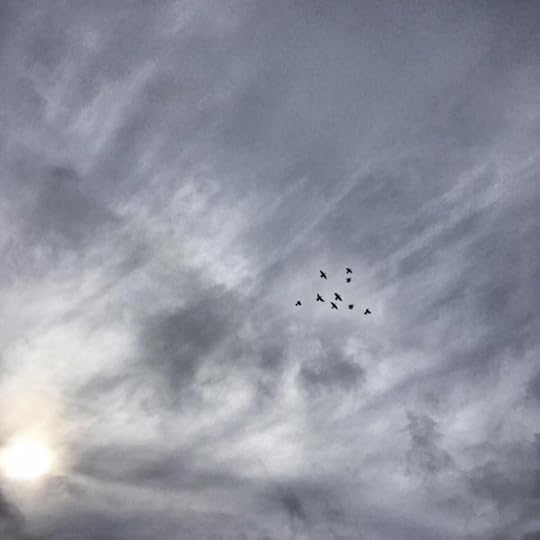 Dearest monks and artists,
Dearest monks and artists,
"What is serious to men is often very trivial in the sight of God. What in God might appear to us as 'play' is perhaps what He Himself takes most seriously. At any rate the Lord plays and diverts Himself in the garden of His creation, and if we could let go of our own obsession with what we think is the meaning of it all, we might be able to hear His call and follow Him in His mysterious, cosmic dance." ~ Thomas Merton, New Seeds of Contemplation
We live in the midst of chaotic times. As crises continue to build, we may find ourselves confused or fearful. We may want to gather in the upper room of our lives with our closest friends and close the door on a troubled world just like the disciples. Yet chaos always calls for creative response, it always beckons us to open to holy surprise.
Today is the feast of Pentecost, that glorious final day of the season of resurrection. The Apostles were together experiencing bewilderment over how to move forward when the Holy Spirit flows among them and breathes courage into their hearts. If we have stayed committed to our pilgrimage this far then we may still wonder why we have journeyed so long and still are do full of fear and unknowing.
It says that those who witnessed this event were "amazed and perplexed." Some were confused, others cynical. Peter reminds the crowds of the words the prophet Joel declared, that all will be called to dreams and visions, all will need to be attentive to signs and wonders.
The story of Pentecost asks us a question: How do I let my expectations and cynicism close my heart to the new voice rising like a fierce wind?
In Benedictine tradition, conversion is a central spiritual practice. Conversion for me essentially means making a commitment to always be surprised by God. Conversion is the recognition that we are all on a journey and always changing. God is always offering us something new within us. Conversion is a commitment to total inner transformation and a free response to the ways God is calling us and to new images of God. Eugene Peterson describes it this way: "What we must never be encouraged to do, although all of us are guilty of it over and over, is to force Scripture to fit our experience. Our experience is too small; it's like trying to put the ocean into a thimble. What we want is to fit into the world revealed by Scripture, to swim in its vast ocean."
Several years ago I was going through an intense period of discernment. I had finished graduate school and found that my desires were no longer in alignment with the path I had initially imagined for myself. I spent long periods of time in silence and solitude, engaging all of the essential techniques for discernment I had learned in my studies and previous practice. I was taking this very seriously because this was my life path I was pondering. Then one night I had a dream about koala bears trying to get a map out of my hands so they could play with me. In my reflection time that followed I discovered a playful God who was calling me to take myself and my discernment far less seriously than I had been. I love to laugh but in my longing to discover the next path, I had forgotten what Merton reminds us in the opening quote: how playfulness is woven into the heart of the universe, how sometimes what God takes most seriously is what we easily dismiss.
Pentecost demands that we listen with a willing heart, and that we open ourselves to ongoing radical transformation. We discover that the pilgrimage does not end here, instead we are called to a new one of sharing our gifts with the world. Soul work is always challenging and calls us beyond our comfort zone. Prayer isn't about baptizing the status quo, but entering into dynamic relationship with the God who always makes things new. Scripture challenges our ingrained patterns of belief, our habitual attitudes and behavior. Conversion is about maintaining what the Buddhists call "Beginner's Mind." St. Benedict speaks to this in his Rule with the call to always begin again.
To be fully human and alive is to know the tension of our dustiness, our mortality, to be called to a profoundly healthy humility where we acknowledge that we can know very little of the magnificence of the divine Source of all. The Spirit descends on those gathered together in a small room and breaks the doors wide open. We are reminded that practicing resurrection is not for ourselves alone, but on behalf of a wider community. Not only for those with whom we attend church services, but beyond to the ones who sit at the furthest margins of our awareness. Pentecost is a story of the courage that comes from breaking established boundaries.
We may limit our vision through cynicism, but equally through certainty or cleverness. Sometimes we fear doubt so much that we allow it to make our thoughts rigid, we choose certainties and then never make space for the Spirit to break those open or apart. The things we feel sure that God does not care about may be precisely the source of healing for a broken world.
Life isn't about knowing with more and more certainty. This is the invitation of our creative practice as well, to move more deeply into the mystery of things. I find that the older I get, the less sure I am about anything and the richer my life becomes as I make space for unknowing, expansiveness, and possibilities far beyond my capacity for imagining. If when Pentecost arrives you do not find yourself perplexed or amazed, consider releasing the tight grip of your certain thoughts and make space for holy surprise.
With great and growing love,
Christine
Christine Valters Paintner, PhD, REACE
Photo © Christine Valters Paintner
May 30, 2017
Monk in the World Guest Post: Lacy Clark Ellman
I am delighted to share another beautiful submission for the Monk in the World guest post series from the community. Read on for Lacy Clark Ellman's reflection on pilgrimage.
I first learned about Iona while in graduate school. Even though I’d spent six months studying abroad in the UK in college, I never made it up to Scotland. Instead I savored my season as a small-town-girl-turned-city-dweller, fully immersing myself in the wonders of London and the community I found there.
It was a season of autonomy for me, and I enthusiastically shed what was old like a snake leaving dead skin behind. As it was my final semester in college, it was also a threshold season—a period of transition and a pause between what had been and what was to come.
Like any liminal space, that threshold season was ripe with new awarenesses of self and new experiences of God, and as I finished my semester abroad with a summer of travel, my intrepid journeys served as a backdrop and catalyst for the transformation that was already stirring within. As time passed and the number of stamps in my passport grew, I found that my travel experiences were impacting my spirituality—both my connection to God and my True Self—and my spirituality was in turn informing my travel experiences. Though I didn’t have the language for it at the time, not only was I falling in love with the practice of pilgrimage—I was fully immersed in it.
A few years later, however, I did find the words and was able to name the practice that had guided me in such transformative ways. They came to me through the passing comments of a mentor (don’t they always?), who was heading to Egypt for a week. It was a trip she had wanted to take for a long time; it was a journey she would be making on her own; it was a pilgrimage.
This is it, I thought. This is what I have experienced, and this is the way of being—of longing, of seeking, of transformation—that I know to be true.
It didn’t take long for me to pore over Phil Cousineau’s The Art of Pilgrimage (recommended by that mentor and the textbook for any pilgrim) and change my degree program so that the practice of pilgrimage could be my focus. As is common with the archetype of pilgrimage, soon other pilgrims and sage guides began to cross my path, and it was from them that I learned of the Isle of Iona, a small island off the west coast of Scotland.
A pilgrimage destination for centuries and a sacred site since St. Columba began his ministry there nearly 1,500 years ago, Iona is commonly referred to as a “thin place”—a location where the veil between heaven and earth seems thin, and human and divine meet in extraordinary ways. Its rugged, sparse landscape inspires peace and contemplation, making it feel as if you were at the edge of the world, and its Celtic heritage highlights the many ways in which the sacred can be found in everyday life.
Even the journey to Iona mimics the journey within, as if slowly peeling away layers of the soul until you finally reach its center. The voyage requires trains, two ferries, and a drive between them until you eventually reach Iona’s shores, in the end arriving not so differently than Columba did fifteen centuries ago. I was able to make the journey five years ago with my husband, and when the time finally came for me to lead a pilgrimage of my own, Iona was where I wanted to begin.
We returned from our journey just over two months ago, and to simply say it was a meaningful experience for each of us would be an understatement. I knew I didn’t want to just take this group of pilgrims to a pilgrimage destination—I wanted to facilitate a fully immersive pilgrimage experience—and our trip to Iona allowed us to do just that.
This means that our pilgrimage didn’t begin when we boarded a plane or disembarked on Iona’s shore, but instead in the moment that we each said “yes” to the journey—when we answered the invitations of the divine and responded to the longing of our souls. It means that even though our trip was months away, we fully immersed ourselves in preparations—mind, body, and soul—asking questions that would inspire our quest, seeking out guides for the path ahead, and sharing our desires and intentions with companions who could journey with us from afar in thought and prayer. It means that we ritualized our sending, blessed our going, and made our way to the island on the first day of our journey in reverence with silence and awe.
Once we arrived on Iona, we immersed ourselves in the pilgrim experience by moving slowly, committing time to practice and presence, engaging in both rest and play, and establishing regular rhythms of reflection. The pilgrim’s journey is not simply one of retreat, however, but of traveling beyond borders and exploring foreign terrain, and so we practiced this by welcoming the stranger, greeting trials with curiosity, and courageously traversing unfamiliar landscapes, both on the island and in the soul (including a few falls in the mud in both accounts!). Much like the story of Jacob in Genesis (whose grandfather, Abraham, was the first recorded pilgrim), we wrestled with the sacred in the wilderness, and in the end, we were blessed.
The pilgrim’s journey isn’t finished, though, once the pilgrim returns home, and so even after our time on Iona came to a close, I encouraged the pilgrims to hold the journey near as the revelations of the journey continued to unfold. And in the months that have followed, though many miles (and sometimes states) stand between us, we’ve remained connected through shared memories and conversation as we honor the journey and savor what remains, each pilgrim discerning how to integrate her experience on Iona into life at home in her own way. After all, the practice of pilgrimage is only a crucible; true change must be sustained in the everyday.
Now that my first pilgrimage is in the books, I’m eager for more. My mind is on fire with sparks of inspiration for future journeys—food and monasticism in Italy; intentional community in the Alps; new faces of God on Bali, the island of a thousand temples—but I’m most excited to extend the pilgrimage experience beyond the group setting and to accompany and guide pilgrims from afar through the launch of my new program, Journey Guide.
A step-by-step pilgrimage companion for the journey of a lifetime, Journey Guide is a multimedia resource for the pilgrim who wants to infuse her travel experience with spirituality and intention. Perfect for pilgrims traveling solo or individuals on group pilgrimages alike, Journey Guide makes it easy to ensure that the impact of your journey will last long after you return home. With reflections, prompts, and worksheets to personalize your experience and pilgrim resources, audio interviews, and meditations to inspire, you’ll be fully equipped to journey with intention and return home transformed. Journey Guide even provides the opportunity to work with me one-on-one so that you have a seasoned traveler and guide to journey alongside you each step of the way
Join me, fellow pilgrim, in the practice of pilgrimage on this journey of a lifetime? Whether you set off on pilgrimage to far off lands or journey with intention right at home, may your steps be blessed and your life be changed.
Want to know more? Lacy will be sharing about Journey Guide and her recent trip to Iona via Facebook Live on her Facebook page tomorrow, June 1, at 1 pm PT. Tune in live for a chance to win a pendant made from a stone collected at Columba’s Bay!
 Lacy Clark Ellman, MA, is a spiritual director and guide who speaks the language of pilgrimage and is always ready for the next adventure. She is a lover of food, books, spirituality, growing and making things, far off places and lovely spaces. Lacy writes about spirituality and intention in travels and daily life at asacredjourney.net and creates resources for the pilgrim at home and abroad, including handmade and designed items in the Journey Shop. Learn more about Journey Guide, her latest creation and pilgrim offering and a step-by-step companion for the pilgrimage of a lifetime, here.
Lacy Clark Ellman, MA, is a spiritual director and guide who speaks the language of pilgrimage and is always ready for the next adventure. She is a lover of food, books, spirituality, growing and making things, far off places and lovely spaces. Lacy writes about spirituality and intention in travels and daily life at asacredjourney.net and creates resources for the pilgrim at home and abroad, including handmade and designed items in the Journey Shop. Learn more about Journey Guide, her latest creation and pilgrim offering and a step-by-step companion for the pilgrimage of a lifetime, here.
May 29, 2017
Writing on the Wild Edges – Poems from Participants (Ann Smith)
This past April we led one of our Writing on the Wild Edges retreats on the beautiful island of Inismor off the coast of Galway. We will be sharing some of the writing which participants gave us permission to share here in the next few weeks. We continue with haiku and photos from spiritual director Ann Smith. (If you'd like to join us, we have our dates open for 2018 – August 26-September 1)
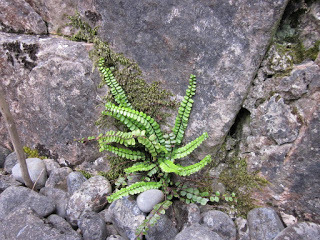
Ancient prayer grows
from the stone. Small fern speaks life
into hopeful hearts.
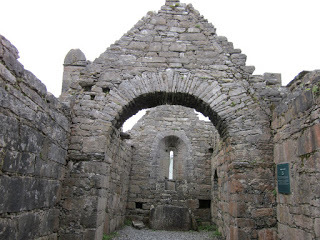
Warmth of holiness.
Sanctuary of silence.
Eternity speaks.
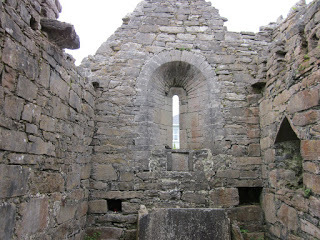
I offer my heart
on this ancient altar as
prayers seep from stones.
—Poems and photos by Ann Smith (you can visit her website here)



